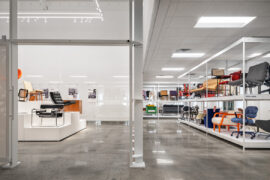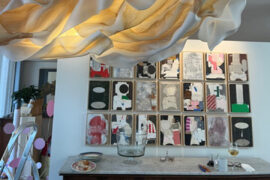The Queensland University of Technology’s Creative Industries Precinct suggests that collaboration should come easy.
“The Creative Industries Precincts’ studios are world-class, and the public spaces are jaw-droppingly beautiful.” – Greg Jenkins, Head of Studies: School of Media Entertainment and Creative Arts, QUT Creative Industries
It is difficult to believe that this thriving hub of dance, drama and music was once a former army barracks. Such is the degree of transformation achieved by HASSELL and Richard Kirk Architect for the Queensland University of Technology’s (QUT) Creative Industries Precinct.
Seeking a brand new facility to house the university’s creative disciplines – comprising, but not limited to, performance studies, film and animation and creative research programs – QUT’s Creative Industries Precinct offers students a dynamic destination in which students are invited to learn, create, experiment and perform together on a 24/7 basis.
Given the innovative and imaginative scope required by QUT’s combined creative faculties, the precinct’s various spaces needed to maintain a high level of flexibility while also strategically allowing a foretaste for passers-by of the exciting work undertaken within. As you walk through the precinct, little vignettes of ingenuity delight – making a very positive message about the future of Australia’s creative prowess.
According to HASSELL, “the building supports a trans-disciplinary approach to teaching and learning – for a precinct that’s social, immersive and multi-connected.” Throughout, the spaces for academic learning have cast aside the enclosed, cellular formats of yore to instead welcome a more approachable, collaborative model of teaching and learning. Couple this with a variety of different amenities – from research labs to shared spaces, performance spaces and beyond – QUT has succeeded in developing one of Australia’s leading ‘sticky campus’ environments.
“From the minute we opened the doors,” comments Jenkins to Michael Keniger for ArchitectureAU, “it was clear we were on a winner. Smiles and goggle eyes everywhere. A pleasant hum of activity from the foyers forms a backdrop to my office. Dancers are warming up in the corridors and eating their lunch in the kitchens. Drama students are going to rehearsals, then discussing their work at the tables adjacent and even occupying meeting rooms. Musicians are running jam sessions. The building needs no user manual and, as I suspected, the students will lead the culture in the spaces.”
Wherever the eye alights, you have a distinct feeling that this is more of a functioning and supportive community than a tertiary education institution. At the heart of the Creative Industries Precinct, a six-storey building houses QUT’s dance, drama, music, animation, creative writing and research programs. Designed around the concept of high circulation, this central nucleus celebrates the precinct’s community-oriented philosophy to “deliberately put people in each other’s paths daily.” Flooded with natural light, bright and airy interiors punctuated with an array of collaborative furniture showcase the ingenuity, co-operation and mutual adoration of imagination that QUT’s staff and student bodies exemplify.
Given the constantly transitional and responsive nature of modern tertiary curricula, the building supports the idea that porous learning spaces are future-proofed for ongoing adaptation. Transparent and adaptable, the development has provided the wider community with a coherent system of energetic public spaces.
Recognised as one of the most significant high-tech creative education spaces across Australia, the level of sophistication needed to facilitate the incubation of tomorrow’s creative leaders cannot be overstated. Deemed an acropolis of creativity innovation and performance, everything from exhibition spaces to restaurants, auditoriums to formal learning spaces, all coalesce across the precinct’s seven core buildings. The result? Shared ambition. Common enterprise. The curtain rises on one glitteringly artistic future.
INDESIGN is on instagram
Follow @indesignlive
A searchable and comprehensive guide for specifying leading products and their suppliers
Keep up to date with the latest and greatest from our industry BFF's!

The undeniable thread connecting Herman Miller and Knoll’s design legacies across the decades now finds its profound physical embodiment at MillerKnoll’s new Design Yard Archives.

For Aidan Mawhinney, the secret ingredient to Living Edge’s success “comes down to people, product and place.” As the brand celebrates a significant 25-year milestone, it’s that commitment to authentic, sustainable design – and the people behind it all – that continues to anchor its legacy.

‘The Mandate Mirage: 2025 Workplace Futures Survey’ is a new report by international design practice Hassell, revealing that the real drawcard for attracting employees to the office in-person is choice.

With a minimalist aesthetic and an inventive approach to product, ZETR is challenging the way electrical accessories are designed, made and experienced.

The final day of CPD Live’s 2025 season delivers three must-attend sessions exploring circular design for furniture and fitouts, and the science behind safe, high-quality drinking water. Starting from 9 AM AEDT, 16th October – it’s your last opportunity this year to join our Live CPD sessions and finish 2025 inspired.
The internet never sleeps! Here's the stuff you might have missed

‘The Mandate Mirage: 2025 Workplace Futures Survey’ is a new report by international design practice Hassell, revealing that the real drawcard for attracting employees to the office in-person is choice.

Held in a private Melbourne residence, Fletcher Arts’ annual exhibition unites over 30 Australian artists and designers in a setting where art meets architecture.